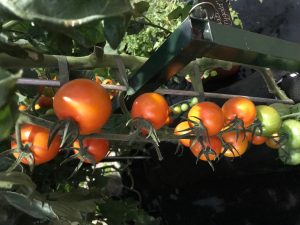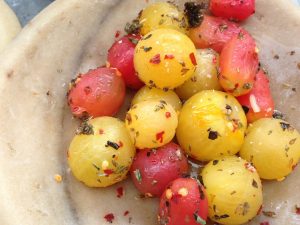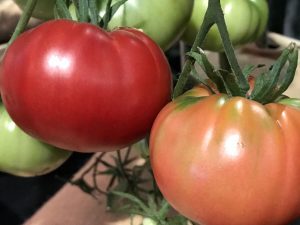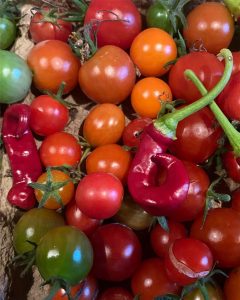If you grow tomatoes, you are probably now awash with lots of fruit. It’s a great challenge finding ways to use up a glut of tomatoes and there are many wonderful ways to make use of this fabulous, flavour filled surplus.
Gardeners that grow tomatoes should now have a bit of a glut and be looking for ways to use up the surplus. In recent years tomato blight has completely decimated the efforts of many amateur gardeners just as the fruit was hanging off the plants by the kilo, turning their prize tomatoes to blackened mush. As a result many gardeners have given up growing outdoor tomatoes and concentrated on greenhouse varieties that can be grown under glass or polytunnel protection. Those that were more daring and planted surplus outside, or have chosen to grow blight resistant types are now reaping the fruits of their labour. This summer the heat wave has kept tomato blight mostly in check, so a quick look around local allotment plots and home gardens, will reveal plants dripping in rich, ripe fruits that are so sweet even the wasps have taken an interest.

Freshly picked
There is nothing quite like the taste of freshly picked tomatoes, especially when they are warm and fragrant picked just from the plant. And when they have been grown without a pesticide dressing and in organic compost they could be described as ‘organic’ or pesticide free, an added bonus if you are totting up their value.
Tomatoes can be eaten raw or fresh in salads or as a ‘veg’ side dish for summer menus. In fact that is the very best way to savour their essence, specially if you have grown a variety so sweet or tasty chosen for its flavour alone. But don’t disregard tomatoes as an ingredient of cooked dishes they are a wonderful addition to most meals. They don’t freeze particularly well, although frozen tomatoes are ideal for cooking, instead many gardeners and cooks prefer to bottle, chutney and sauce surplus tomatoes for winter use.

Roast tomatoes
When you’ve run out of bottles and jars and still have pounds of tomatoes to preserve, then cut them in half, remove the woody core and any blemishes. Place them cut side down into a large baking dish. Cut the skins into a grid like pattern and grind some black pepper over the top, then drizzle olive oil generously over each tomato. Add some herbs like chives, rosemary or oregano depending on your tastes? Place the baking dish low down in the oven when you are next baking and allow the dish to stay in the oven as it cools down. Keep an eye on the tomatoes; they need a few hours of a warm oven to reduce down to a thick, oily tomato paste, which can then be frozen inside ice cube trays or small amounts in the freezer. It’s an ideal ingredient for winter soups, stews and pasta dishes, recreating the taste of summer in the middle of winter.

Green tomatoes
Sometimes you can end up with a stash of unripe tomatoes, especially towards the end of the season. Green tomatoes can be harvested and then ripened indoors or even in the greenhouse, just keep them frost free. They will even ripen in the dark. You can speed up the ripening process by mixing a few ripe tomatoes with the green ones or by placing ripening bananas nearby. Don’t forget that green tomatoes can be used in a variety of recipes, but most will go on and ripen if you have space to keep them and are patient.

Saving seed
If you’ve grown a particularly tasty variety this year or you have a heritage tomato that you want to keep growing then save some seed. Unless you have an F1 variety, which won’t come true from seed, most other tomatoes will be pretty true to the parent. Simply take one tomato from a healthy, vigorous plant and carefully cut it open to remove the seed. Place the seed into a small bowl with some tepid water and leave to ferment for 3-4 days. This breaks down the jelly coat that surrounds each seed
Tip the liquid out and separate the seeds onto a piece of kitchen towel. Spread them out and they will stick to the towel as they dry. You can write the variety name on the kitchen towel and store the seeds in a cool dry place in envelopes to sow next year. Why not add a small piece to your Christmas cards giving the recipient the means to grow a great tomato next season and share in the love of your hobby.


